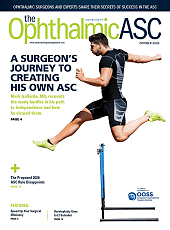When the lipids, proteins, mucins, and electrolytes in natural tears are disrupted, patients start to experience signs and symptoms of dry eye disease (DED). The Tear Film & Ocular Surface Society’s (TFOS) third dry eye workshop (DEWS III) reports that DED “afflicts hundreds of millions of people worldwide, is a leading cause of patient visits to eyecare practitioners, and, if moderate or severe, is associated with significant pain, role limitations, low vitality, and poor general health.”1
Previously, the TFOS DEWS II report guided physicians toward lubricants and pharmacologic agents as first-line treatments and positioned biologics, such as autologous serum tears (AST), as a third-line option. The new TFOS DEWS III guidelines, however, prioritize a personalized approach that is specific to each patient and considers underlying causes, rather than the stepped approach of the past.1
With this paradigm shift, said Vital Tears president Rajan Shukla, AST could become a first-line treatment—particularly in cases of neural dysfunction in which patients need growth factor supplementation or ocular surface regeneration after damage. Autologous serum tears contain many of the same components as natural tears, including epidermal- and nerve-growth factors, vitamins, and fibronectin. These promote epithelial growth, reduce apoptosis, and distinguish serum tears from artificial lubricants that provide only temporary relief.2
Serum tears are derived from the patient’s own blood, which minimizes the risk of immune reaction.2 The formulation’s osmolarity and pH are comparable to natural tears, and a balanced salt solution is the only additive, Mr. Shukla pointed out.
“If patients experience irritation, they can use 100% serum—an undiluted but sterilized preparation of their own blood,” he added.
Benefits for Patient and MD
Serum tears have historically faced barriers to widespread use. In the past, they were prepared in physician offices or compounding pharmacies under variable conditions, which raised concerns about sterility, dosing consistency, and accessibility.1 Vital Tears, founded in 2014, sought to address these challenges by centralizing production. According to Mr. Shukla, physicians now order serum through an online portal, after which the patient’s blood is drawn at a local center or by a mobile phlebotomist. Samples are then shipped to a Kansas City facility, where the serum is separated, sterilized, and packaged into dropper bottles for a 6-month supply. The final product is typically delivered to patients within 48 hours.
Clinical research has demonstrated the benefits of AST in improving both symptoms and objective signs of DED. A randomized clinical trial of 300 patients with severe DED compared artificial tears with AST over 12 weeks.2 Patients receiving serum tears achieved greater improvement in Ocular Surface Disease Index (OSDI) and Visual Analog Scale (VAS) scores, as well as superior outcomes on tear breakup time (TBUT), Schirmer testing, and fluorescein staining.2 Safety outcomes were favorable, with only mild irritation reported in a minority of patients.
The average patient cost for AST through Vital Tears is about $130 per month. While it is historically a self-pay therapy, Kaiser Permanente and Aetna now recognize serum tears as medically necessary, said Mr. Shukla, adding that negotiations with other major payors are ongoing.
“We set our price to be as affordable as possible while covering the unique processing requirements of serum tears: blood collection, shipping, and individualized preparation,” Mr. Shukla explained. “Expanding insurance coverage is a key initiative to reduce out-of-pocket costs further.”
Seeing Is Believing
Feedback from patients and providers has influenced adoption of AST. According to Mr. Shukla, many clinicians initially try serum tears with one patient, then, after observing positive outcomes, expand use across their practice.
“Seeing is believing,” he explained. “Physicians place that first order, hear from a patient who feels much better, and soon they are placing orders weekly.
“Patients don’t say, ‘Thanks for increasing my Schirmer score,’ or ‘Thanks for decreasing my fluorescein staining,’” Mr. Shukla continued. “They say, ‘I feel so much better! I can drive, I can read…I feel like I got my life back.’ That’s ultimately what matters most—patients being able to return to the things they love.”
Additional data on the efficacy, long-term adherence, and real-world utilization patterns of serum tears compared with approved pharmacologic therapies is forthcoming. Further areas of study may include cost comparisons between step therapy and serum tears alone.
Meanwhile, Vital Tears is offering physician webinars on market education and changes to the ocular surface workup since the DEWS III update. OM
References
1. Jones L, Craig JP, Markoulli M, et al. TFOS DEWS III Management and Therapy Report. Am J Ophthalmol. Published online June 2, 2025. doi:10.1016/j.ajo.2025.05.039
2. Abed MA, Hameed AA, Al-Mahdawi SAJ. Artificial tears vs. autologous serum eye drops: Which is more effective for severe dry eye? Int J Ophthalmol Res. 2025;7(1):01-08. doi:10.33545/26181495.2025.v7.i1a.26









